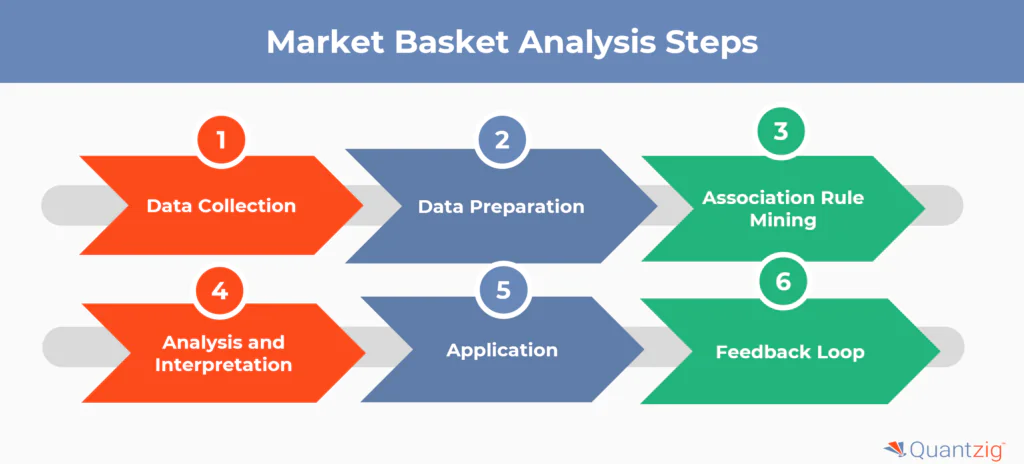Table of Contents
Introduction to Market Basket Analysis
Market basket analysis (MBA) is a powerful data mining technique that enables retailers to gain valuable insights into customer purchasing behaviour by examining large datasets of transaction records. This approach identifies frequently purchased product combinations, revealing hidden patterns that can inform strategic decisions to boost sales and enhance the customer experience.
The widespread adoption of electronic point-of-sale (POS) systems has greatly facilitated the implementation of market basket analysis, as digital transaction data is more easily collected, stored, and analyzed compared to traditional handwritten records.
Quantzig enabled a major wholesale club retailer with over 600 locations in the United States and annual revenue exceeding $240 billion, in implementing market basket analysis. The client transformed its sales strategies through this implementation, substantially improving cross-selling revenue and inventory
management.
Main Market Basket Analysis Pointers
- Sentiment analysis is crucial for retail success, enabling businesses to act on real-time customer insights and improve engagement.
- By understanding customer preferences and addressing feedback promptly, retailers can enhance satisfaction and foster loyalty.
- Sentiment analysis extracts actionable insights from both structured and unstructured data, offering a precise view of customer sentiment.
- With sentiment forecasting, retailers can anticipate trends, adjust strategies proactively, and drive sustainable growth.
- Quantzig’s AI-driven sentiment analytics provides retailers with accurate, real-time insights to optimize marketing and enhance customer experience.
Book a demo to experience the meaningful insights we derive from data through our analytical tools and platform capabilities. Schedule a demo today!
Request a Free DemoWhat is Market Basket Analysis?

Market basket analysis is a data mining technique used by retailers to uncover hidden patterns in customer purchasing behavior by analyzing large datasets of transaction records. It identifies products that are frequently purchased together, revealing valuable insights into customer preferences and shopping habits to optimize product placement, pricing, and marketing strategies.
How Quantzig’s Market Basket Analysis Solution Helped an Organic Foods Retailer Increase Quarterly Sales
Client Overview
The client is a prominent wholesale membership club operating in the United States, known for its wide range of high-quality merchandise at discounted prices. With over 71 million paid members and an impressive 92.7% renewal rate, the company aims to provide exceptional value and shopping experiences to its diverse customer base.
Challenges Faced
The client encountered several challenges in optimizing its retail operations:
- Difficulty in identifying cross-selling opportunities across its vast product range of over 4,000 SKUs
- Limited insights into customer purchasing patterns across different product categories
- Limited understanding of how seasonal variations affect product associations
- Struggle to personalize promotions for its diverse membership base, including both individual consumers and businesses
- Challenges in inventory management due to unpredictable demand patterns
Quantzig’s Solution
Quantzig implemented a comprehensive clickstream analytics solution, leveraging advanced data science techniques:
- Data Collection and Preprocessing: Gathered and cleaned vast amounts of transaction data from the client’s point-of-sale systems across its 600+ locations across the US.
- Association Rule Mining: Applied algorithms like Apriori to identify frequent item sets and generate association rules from millions of transactions.
- Cross-Selling Opportunities: Analyzed data to uncover potential cross-selling opportunities across various product categories.
- Promotional Strategy Optimization: Developed targeted promotional strategies based on identified purchasing patterns.
Implementation Process: Clickstream Analytics
The project was executed in three phases, aligning with the client’s quarterly business cycles:
- Data Analysis: Conducted in-depth analysis of historical transaction data, processing over 1 billion transactions annually to extract actionable insights on product associations.
- Insight Generation: Conducted in-depth analysis to extract actionable insights on customer purchasing behaviour and product affinities.
- Strategy Optimization: Leveraged insights to refine promotional strategies and enhance inventory management practices.
Results and Impact
Quantzig’s market basket analysis solution delivered significant improvements for the client:
- 12% increase in average transaction value, bringing it closer to $110 per visit (up from around $100)
- 15% reduction in inventory holding costs by better-aligning stock levels with actual purchasing patterns
- 20% improvement in promotional campaign effectiveness through targeted, personalized offers to different member segments
- 8% increase in member renewal rates, attributed to more relevant product offerings and improved shopping experience
Experience the advantages firsthand by testing a customized complimentary pilot designed to address your specific requirements. Pilot studies are non-committal in nature.
Request a Free PilotKey Benefits Realized
- Enhanced Cross-Selling: Identified strong product associations, enabling more effective bundling and promotional strategies across diverse categories from groceries to electronics.
- Optimized Promotional Strategies: By understanding customer purchase affinities, the retailer could refine its promotional efforts for better targeting and efficiency.
- Improved Inventory Management: Better forecasting of product demand led to reduced stockouts and overstock situations, crucial for managing the large-scale inventory of a wholesale retailer.
- Enhanced Customer Experience: By offering promotions on popular product combinations, the retailer improved customer satisfaction and loyalty.
- Personalized Marketing: Tailored promotions based on individual member purchasing habits and business vs. individual consumer segmentation, increasing response rates and member loyalty.

Market basket analysis is one of the most commonly used retailing techniques to increase sales. By leveraging this tool, retailers can determine product affinity and understand the reason behind products purchased together. Knowledge of the products frequently purchased as a group will enable retailers to efficiently plan their store layout. Retailers can also extract insights from market basket analysis and utilize it to develop new products without compromising on the market trends.
How to leverage Market Basket Analysis

Data Needed for Market Basket Analysis
Market Basket Analysis relies on transactional data collected from various sources such as point-of-sale systems, online shopping platforms, and customer databases. This data includes detailed information about each transaction, such as the products purchased, the quantity of each product, the date and time of the transaction, and the customer’s demographic information.
For example, Quantzig collected data from millions of customer transactions across the e-commerce platform and physical stores for the client. This information was used to gather insights into the products purchased together, the frequency of these purchases, and the customer’s shopping behavior over time.
Market Basket Analysis Implementation
MBA involves analyzing the transactional data to identify patterns and associations between products. The steps include:
Data Collection:
- Transaction Data: Gather detailed transaction data from all sources, including in-store purchases, e-commerce transactions, and customer loyalty programs.
- Product Information: Collect comprehensive product information, including product IDs, categories, and descriptions.
Data Preprocessing:
- Data Cleaning: Remove any inconsistencies or errors in the data, such as missing values or duplicate entries.
- Data Transformation: Convert the data into a suitable format for analysis, typically a binary matrix where rows represent transactions and columns represent products.
Choosing the Right Algorithm:
- Apriori Algorithm: A popular choice for MBA, it identifies frequent item sets and generates association rules based on user-defined minimum support and confidence thresholds.
- FP-Growth Algorithm: An efficient alternative to Apriori, it constructs an FP-Tree to store crucial information about frequent item sets.
- Eclat Algorithm: A depth-first search algorithm that uses a vertical data format to efficiently discover frequent item sets.
Analysis
- Frequent Item set Mining: Use the chosen algorithm to identify frequent item sets, which are sets of products that are often purchased together.
- Association Rule Mining: Generate association rules from the frequent item sets, which indicate the likelihood of purchasing one product given another.
- Pattern Evaluation: Evaluate the patterns identified by the algorithms, focusing on metrics such as support, confidence, and lift.
Insight Generation:
- Product Affinity: Identify which products are often bought together, enabling targeted cross-selling and bundling strategies.
- Customer Segmentation: Segment customers based on their purchasing patterns to tailor marketing efforts and improve customer engagement.
- Inventory Optimization: Use MBA insights to optimize inventory levels, reducing stockouts and overstocking.
Strategy Optimization:
- Cross-selling and Upselling: Develop targeted promotional strategies based on identified product affinities.
- Inventory Management: Adjust inventory levels according to MBA insights to ensure adequate stock of frequently purchased products.
- Customer Engagement: Personalize shopping experiences by recommending products based on customer purchasing patterns.
Implementation and Monitoring:
- Integration with Existing Systems: Integrate MBA insights with existing CRM, ERP, and e-commerce platforms to automate personalized recommendations and inventory adjustments.
- Continuous Monitoring: Regularly monitor and update MBA models to reflect changing customer behaviours and market trends.
Get started with your complimentary trial today and delve into our platform without any obligations. Explore our wide range of customized, consumption driven analytical solutions services built across the analytical maturity levels.
Start your Free TrialImpact of Market Basket Analysis
The implementation of Market Basket Analysis can significantly impact retail operations:
By understanding which products are commonly purchased together, retailers can create effective cross-selling strategies. For example, promoting snacks alongside beverages based on identified purchase patterns can increase sales.
MBA helps in optimizing stock levels for high-affinity products, ensuring popular combinations are always available. This reduces instances of stockouts and excess inventory.
Retailers can develop targeted promotions based on purchasing patterns. For instance, offering discounts on bundled products that are frequently bought together can drive additional sales.
By identifying products frequently bought together, retailers can strategically place these items in close proximity, both in physical stores and on e-commerce platforms.
MBA helps retailers understand customer behavior, enabling them to offer personalized product recommendations and tailored promotions.
By implementing MBA for the client led to significant improvements in customer engagement and sales performance, such as a 12% increase in cross-selling revenue and a 15% reduction in inventory holding costs.
Conclusion
In conclusion, market basket analytics emerges as a cornerstone in the arsenal of modern retailers, particularly in the burgeoning eCommerce sector and bricks-and-mortar stores alike. By leveraging sophisticated algorithms and harnessing the power of data, businesses can optimize sales, enhance the shopping experience, and fortify brand loyalty. Whether through predictive or differential MBA, retailers can strategically place products, offer compelling deals and bundles, and tailor store layouts to align with customer preferences. As the retail landscape continues to evolve, embracing MBA and its associated techniques remains instrumental in navigating the complexities of consumer behavior and achieving sales optimization in the ever-competitive market.




